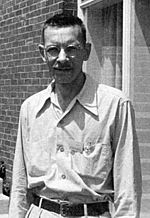Alfred Hershey facts for kids
Quick facts for kids
Alfred Hershey
|
|
|---|---|

Alfred D. Hershey in 1969
|
|
| Born | December 4, 1908 Owosso, Michigan
|
| Died | May 22, 1997 |
| Nationality | United States |
| Alma mater | Michigan State University |
| Known for | bacteriophages |
| Awards | Nobel Prize in Physiology or Medicine 1969 |
| Scientific career | |
| Fields | bacteriology genetics |
Alfred Day Hershey (born December 4, 1908 – died May 22, 1997) was an American scientist. He was a bacteriologist, which means he studied tiny living things called bacteria. He was also a geneticist, meaning he studied genes and how living things pass on traits. Hershey won the Nobel Prize for his important work on viruses and how they copy themselves.
Contents
Who Was Alfred Hershey?
Alfred Hershey was born in Owosso, Michigan. He loved science from a young age. He went to Michigan State University. There, he earned his first degree in chemistry in 1930. Later, in 1934, he got his Ph.D. in bacteriology. After finishing his studies, he started working at Washington University in St. Louis.
Exploring Viruses: Bacteriophages
In 1940, Hershey began working with two other scientists. They were Salvador Luria and Max Delbrück. They studied special viruses called bacteriophages. These viruses infect and reproduce inside bacteria.
Hershey discovered something amazing. When two different types of bacteriophages infected the same bacteria, they could swap genetic information. This was a big step in understanding how viruses work.
The Famous Hershey-Chase Experiment
In 1950, Alfred Hershey moved to Cold Spring Harbor, New York. He joined the Carnegie Institution for Science. There, in 1952, he worked with Martha Chase. They did a very important experiment. It is now known as the Hershey-Chase blender experiment.
This experiment helped prove that DNA is the genetic material. Before this, many scientists thought protein carried genetic information. Hershey and Chase showed that DNA, not protein, was what viruses used to pass on their traits. This was a huge discovery in biology.
A Nobel Prize Winner
Alfred Hershey became the director of the Carnegie Institution in 1962. In 1969, he was awarded the Nobel Prize in Physiology or Medicine. He shared this prize with his earlier partners, Salvador Luria and Max Delbrück. They won for their discoveries about how viruses copy themselves and how their genetic material is structured.
See also
 In Spanish: Alfred Day Hershey para niños
In Spanish: Alfred Day Hershey para niños

